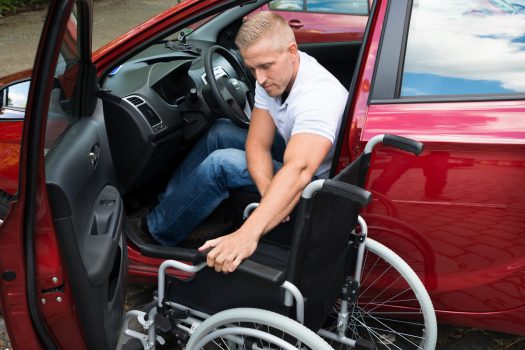With some special adjustments and teaching it is possible for those with disabilities to navigate the roads just like able-bodied drivers. Living with a physical disability does not have to mean you are grounded. The ADA, American Disabilities Act) amended the law in 2008 so that the DMV could not deny someone a license based only on their disability. If you want more answers to your burning questions to continue to read. If you go on to enjoy this post check out our other article on Epileptic Drivers.
Can You Drive if You Are in a Wheelchair?
Yes, thanks to many advances in technology, disabled drivers who use wheelchairs are able to drive. Wheelchairs can be customized to match the motor skills of each individual driver for handicap driving. They are tested by the department of motor vehicles in their home state and when appropriate, restrictions will be noted on their driver’s license. Disabled drivers will also need to be trained at a conventional traffic school or online traffic school.
Can a Paralyzed Person Drive?
While the way in which they learn and tools which are needed might be different, it is still possible for a paralyzed person to drive. Things that are taken into consideration include the severity of paralysis and vehicle the person is operating.
In What States Can a Disabled Person Drive?
State DMV’s are prohibited from denying disabled drivers from securing a driver’s license. Vehicles must be equipped with proper modifications and drivers must still pass a drivers test. Drivers licenses issued in one state are also valid in all other 50 states. You should also check to see if you qualify for a disabled placard in your state. In Florida, you might be eligible for a disabled placard if you suffer from a cardiac condition, can’t walk more than 200ft without resting, as well as other qualifiers.
How Much Does it Cost to Modify a Car for Handicapped?
According to the National Highway Traffic Safety Administration (NHTSA), costs to modify an existing car for handicap driving range from as little as $50 for special mirrors to a few hundred dollars for special hand controls. Specially equipped vehicles with ramps and raised ceilings range from $20,000 – 80,000. You can download a PDF file from the NHTSA website that provides additional information. Some vehicles let disabled drivers actually stay in their wheelchair while driving. Other vehicles allow wheelchairs to fold up for easy storage and transportation. Other possible modifications to existing vehicles include installing wheelchair lifts, raised ceilings and special floor mounts. These modifications tend to be expensive and they must be approved by state DMV’s.

 Live Chat
Live Chat






